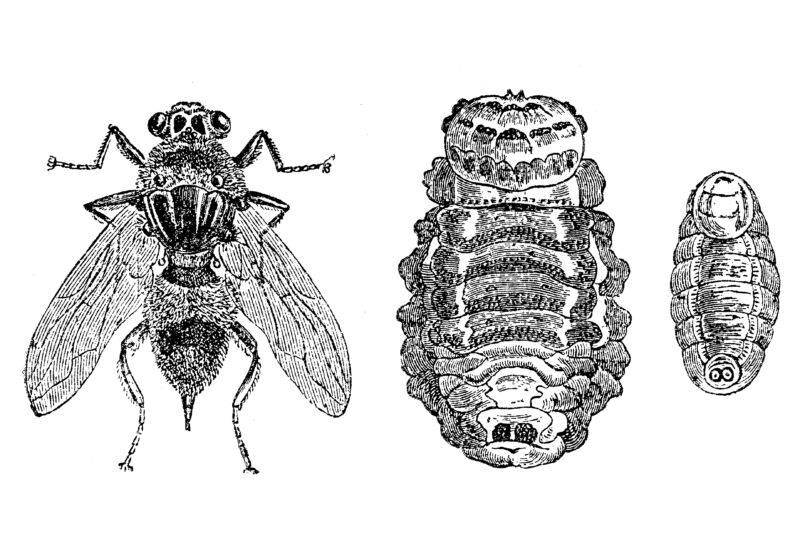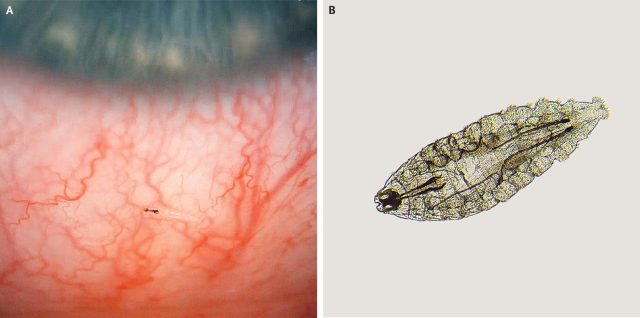This happens when sheep bot fly hatchlings sink their mouth guides into your eyeball.

On Wednesday, specialists in France announced an interesting instance of minuscule sheep bot fly hatchlings — otherwise known as slimy parasites — overrunning the external surface of a man's eyeball.
The little, spiky hatchlings were seen crawling around the man's peeper, which made sense of the redness and irritation he was encountering. Specialists counted in excess of twelve of the upsetting grub-like critters outside the eyeball and encompassing tissue. Specialists had no real option except to cull the bloodsuckers out, individually, utilizing forceps. The specialists additionally recommended skin anti-infection medicines on the off chance that they missed any bugs.
Sheep bot flies, or Oestrus ovis, are tracked down overall in regions with sheep. They ordinarily convey their squirmy posterity to the nostrils of sheep and goats. The hatchlings mature in their nasal nurseries, then, at that point, tumble to the ground and pupate in the climate prior to changing into parasitic irritations. Be that as it may, every once in a while, grown-up female flies become blurred peered toward and lay putrefying agonizes in a human eyeball, causing an infection called ophthalmomyiasis. This is ordinarily an impasse for the flies; the hatchlings for the most part don't make due to adulthood in the natural eye. Be that as it may, assuming you think the lamentable pervasion isn't anything to flinch at, you'd be inaccurate.
Enlightening
Oestrus ovis hatchlings have groups of thick spikes around the beyond their bodies and penetrating snares in their mouth. The spikes can cause aggravation and scraped spots on the external layer of the eye as they wriggle around. This can prompt redness, irritation, enlarging, watering, and a sensation of an unfamiliar body in the eye.
In interesting cases, the hatchlings can likewise tunnel their direction inside the eyeball. Once inside, they can cause more serious harm, including to vision. Side effects can appear as floaters in vision, glimmers of light, lines through vision, and eye torment. Regardless of whether the slimy parasites kick the bucket inside the eyeball — whether by laser medicines or regular causes — the waiting larval carcasses can cause genuine aggravation, which can additionally jeopardize vision. Generally speaking, the results of ophthalmomyiasis, which can be brought about by an assortment of flies, can go from gentle, fleeting inconvenience to visual impairment.

With respect to case in France, distributed Wednesday in The New England Journal of Medicine, the man was fortunate. The pervasion was just outside ophthalmomyiasis, meaning the hatchlings didn't get inside his eyeball. The 53-year-elderly person went to a crisis division in the wake of managing irritation in his right eye for a considerable length of time. He told specialists he was cultivating before in the day close to a sheep homestead and felt something get into his right eye, however he didn't have the foggiest idea what it was.
Specialists noticed that the man had 20/20 vision in the two eyes, however his right eye was red and aggravated. A more intensive look uncovered the squirmy gatecrashers. After the slimy parasites were physically eliminated, the man was given skin treatment. At a 10-day follow-up, the man's eye had returned to ordinary with no different side effects.




![Announcing predisposition [POPPPUUUNNNDDDEERRR] makes homeopathy preliminaries seem to be homeopathy works](https://4.bp.blogspot.com/-O3EpVMWcoKw/WxY6-6I4--I/AAAAAAAAB2s/KzC0FqUQtkMdw7VzT6oOR_8vbZO6EJc-ACK4BGAYYCw/w680/nth.png)



0 Comments
Write a comment if you liked the topic